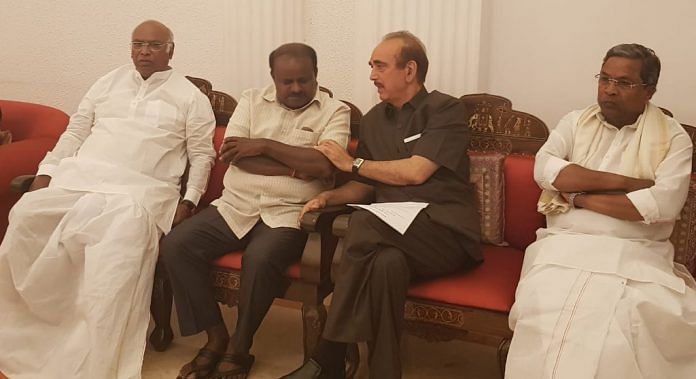Party had emerged as single largest in both states but slammed governors after not being invited to form governments.
New Delhi: The stalemate in Karnataka has echoes of similar scenarios witnessed during assembly elections in Goa and Manipur last year. Only this time, the Congress, which has extended support to the JD(S) to make up the numbers in Karnataka, find itself in the position the BJP was in during those elections.
The BJP, which has emerged as the single largest party in Karnataka, managed to form governments in Goa and Manipur despite having finished behind the Congress in both states.
In the 40-member Goa assembly, the Congress (then in opposition) won in 17 seats, while the BJP could manage only 13. Governor Mridula Sinha, however, invited the BJP to take the first shot at government formation after the party managed to secure the support of the Goa Forward Party and independent MLAs.
In Manipur, the Congress won 28 of the 60 seats on offer, but was still not invited to form the government; Governor Chura Chand Singh instead allowed the BJP, which won only 21 seats, to cobble up a coalition and claim power.
The Congress’s stance in both these states could now come back to haunt it. In Goa, after it became clear that the governor was planning to invite the BJP to form the government, the Congress took exception, and cited the 1988 report by the Justice R.S. Sarkaria Commission to buttress its claim that only the leader of the single-largest party should be invited to form the government.
The Sarkaria Commission, while cautioning that the governor’s “task is to see that a government is formed and not to try to form a government which pursues policies that he approves,” suggested an order of preference that the governor should follow in case no party had a majority. The invitation to form the government in such a situation, the Commission recommended, must be granted to the “party or combination of parties which commands the widest support in the Legislative Assembly”.
Thereafter, the order of precedence, it added, should be: the leader of any pre-poll alliance of parties “formed prior to the elections”; the leader of the “largest single party staking claim to form the government with the support of others, including independents; the leader of a “post-electoral coalition of parties, with all the partners in the coalition joining the government” and, finally, the leader of a post-electoral alliance of parties, with some of the parties in the alliance forming a government and the remaining parties, including independents, supporting the government from outside.
In its April 2007 report on Centre-State relations, the Justice Madan Mohan Punchhi Commission also made similar recommendations.
Denied the opportunity to prove its majority on the floor, the Congress even filed a petition in the Supreme Court, accusing the governor of ignoring the fact that “there was no pre-poll alliance of any party prior to the elections” and that the governor had erred in refusing to invite the single largest party — the Congress — to form the government. Nothing, however, came out of the petition and BJP continues to be in power in Goa.






